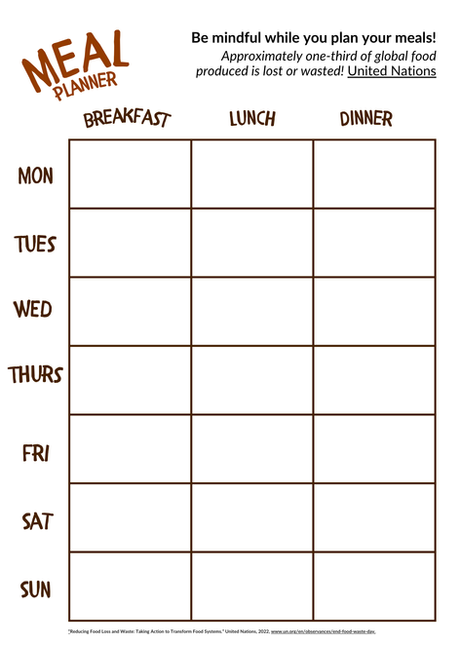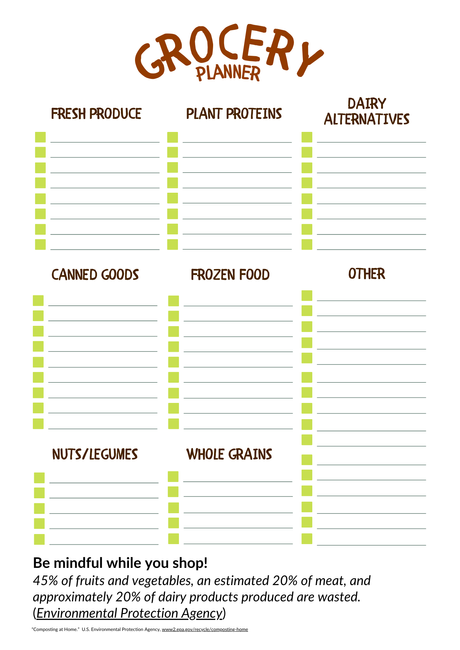How to Stop Food Waste: Students Take Action Together
- Maddison Chaffin
- Aug 27
- 4 min read
Food waste is all around us. From the last couple of bites we scrape into the trash after mealtime, to produce that goes bad before we get to it, and leftovers we forget in the back of the fridge. It doesn’t feel great to toss these scraps because we know it’s not just food. It’s all of the resources that went into getting it to you, from processing to production, transportation, and consumption or disposal.
Although it’s common knowledge that food waste is bad, many people simply don’t know how to prevent it. So, here we are! To fix this dilemma, we have curated a collection of helpful tips from our practical Rethinking Food Waste Guide and education package.
Pssst: Read until the end! We also provide at-home challenges to help inspire you to adopt these habits long term!

Why Does Food Waste Prevention Matter?
The answer is pretty simple. Wasting food is wasting valuable resources. When food gets tossed, all the water, energy, land, and labor that went into producing it go to waste, too. Shockingly, about one-third of food produced globally is wasted. All this wasted food sits in landfills, creating greenhouse gases that contribute to climate change, while the nutrients from it never return to the soil.
How To Stop Food Waste Before Meals?
Reducing food waste is easier than you might think, and it can even save money! Start by making a meal plan and a shopping list so you only buy what you know you’ll use. Before heading to the store, don't forget to check your fridge and pantry, you might already have the pasta or tomatoes you need for tonight’s dinner.
Download these two printables in the Educated Choices Program's "Rethinking Food Waste" guide.
When you’re shopping, don’t skip over the “ugly” fruits and veggies. A whopping 10 million pounds of imperfect foods are tossed into the trash worldwide every year! Just because a carrot is crooked or an apple has a funny shape doesn’t mean it tastes any different. In fact, buying these perfectly good but imperfect-looking foods helps keep them out of the trash and makes a big difference when it comes to cutting waste. It may be tempting to buy convenience foods, but you can reduce food packaging waste by avoiding unnecessary snacks and pre-packaged foods on a whim.
Lastly, remember fresh produce is not the only kind! Frozen and canned goods last much longer. They are also often cheaper, saving you money at checkout and later on, since they are less likely to expire before you get to them.
Pro Tip: Learn to read labels correctly!
“Many consumers misunderstand the purpose and meaning of the date labels that often appear on packaged foods. Confusion over date labeling accounts for an estimated 20 percent of consumer food waste,” (The Food and Drug Administration).
How To Stop Food Waste During Meals?
One easy way to cut down on food waste? Paying closer attention to proportions at mealtimes! Try using the plate method: Fill half your plate with fruits and veggies, about a quarter with protein, and the other quarter with grains. Not only is it a healthy balance, but it also helps keep your portions sensible, so less food ends up in the trash. Keep your portions smaller if you notice yourself not eating the last couple of bites. Those can always be put aside to store properly and save for later.

Another trick is to eat perishable foods such as berries, salad, or fresh bread first before moving on to items that last longer, like rice or canned goods. And don’t forget about leftovers! Don’t let them rot in the back of the fridge. Instead, pick one night a week to turn them into something fun and creative. Stir-fries, soups, or even sandwiches can be made with a variety of leftovers and commonly on-hand pantry staples and spices. It’s a simple way to save money, reduce waste, and get a little adventurous in the kitchen!
How To Stop Food Waste After Meals?
Reducing food waste doesn’t stop when the meal is over. Instead of tossing scraps like fruit cores, veggie peels and stems, or coffee grounds, try composting them so they can turn back into healthy soil.
If you end up with more cooked food than you can finish, pack up the leftovers for tomorrow’s lunch or a quick dinner later in the week, like we previously discussed. And when you find yourself with extra unopened items, consider donating them to a local food bank or pantry, as long as they’re safe and in good condition. These small steps keep good food out of the trash and put it to better use for both people and the planet.
Time For Your Food Waste Prevention Challenge!
Pick one idea below and then act on it! Track what you do, the results you see, and what you learn along the way. If you are a teacher, consider running one of these challenges as a class project. Students, why not present your findings visually or write a reflection on how the activity changed your food habits?
Meal Planning Challenge
Create a week of meals, build a shopping list, and try to avoid plastic packaging whenever possible. Did planning cut down on waste?
Leftover Remix Day
Commit one day a week to using only leftovers or odds and ends from your fridge. Use pantry staples and spices to mix things up. What ingredients did you already have? Was the meal still delicious?
Compost Experiment
Create a compost plan to avoid throwing food scraps in the trash! Here is a great tool to get started: “Composting is Easier Than You Think” by NRDC
Which challenge will you choose?!
Meal Planning
Leftover Remix Day
Compost Experiment
Your Own Challenge
Your Mission? Keeping Learning How To Stop Food Waste
Now, let's turn that spark of awareness into real change. Keep the conversation going, stay curious, and make choices that feed our health and the planet. Ready to get started? Learn even more by downloading the guide here.









